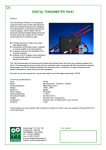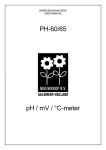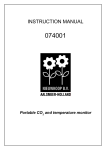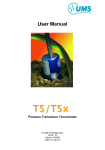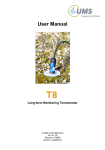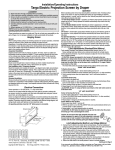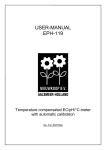Download TMI Engels [Gebruiksaanwijzing]
Transcript
USER MANUAL TM-STW Tensiometer with electronic output USER MANUAL TENSIOMETERS Preface Congratulations with your Nieuwkoop Tensiometer. The principal of Tensiometers have been used in soil scientific research since 1930. From that moment the Tensiometer is successfully used in agriculture and horticulture. Nieuwkoop is manufacturer of Tensiometers in this sector for more than 25 years. Using Tensiometers will give you a better opinion about the conditions. This makes it possible to tune irrigation schedules better to the needs of the plants. This will result in a saving of water and nutrients and will give a bigger production. The Tensiometer is a good help to minimalism the drain. This will result in a better environment. Thanks to the new line of Tensiometers with electronic output, it is possible to have a continuous control of the conditions. This will help you to protect the plants against diseases caused by to much water or less production because of water stress. From now on guesswork in scheduling irrigation belongs to the past. Good luck with your Tensiometer. Measuring principal Tensiometers are the only instruments that measure directly the suction a plant needs to subtract water from the rock wool. A Tensiometer consists of a hollow tube connected to a ceramic tip at the bottom. A rubber stopper closes the tube at the upper side. The tube has to be filled with demi-water or distilled water. After this the tube has to be placed into the rockwool. When the rock wool gets dry it will subtract water from the tube through the ceramic tip. This will cause a vacuum in the tube. When the vacuum is equal to the suction of the rockwool, the water flow through the ceramic tip will stop. When the rock wool gets wet through rain or irrigation, the Tensiometer will subtract water from the rock wool through the ceramic tip caused by the vacuum into the tube. Because of this the vacuum will decrease until it is equal to the rock wool suction. When the rock wool is saturated, water can freely flow in and out the tube, so there will be no vacuum into the tube. In this way we can see the Tensiometer as a synthetic root of a plant where the vacuum is always in balance with the rock wool suction. We can use this as a standard for the suction a plant needs to extract water from the rock wool. Measuring vacuum The measuring principle of Tensiometers have been used in soil scientific research since 1930. These Tensiometers used Mercury or water columns to measure the vacuum. Later this was replaced by a Bourdon pressure-gauge. Nowadays vacuum can be measured by electronic sensors. With these sensors it is possible to measure the pressure more accurate. The sensors have an electronic output that can be connected to a controller or computer. The TMSTW with replaceable ceramic tip of Nieuwkoop BV is a Tensiometer of this type. The international standard for measuring pressure is Pascal (Pa). Other standards for measuring the pressure are: hPa, cm H2O column or pF. However we will use the international standard and measure in hectopascal (1hPa = 100Pa). The conversion to the other units is: 1hPa=1hPa=1 cm H2O column. The pF is the logarithmic value of the pressure in hPa. The pressure in the Tensiotube is measured compared to the barometric pressure. The Tensiometers will be calibrated in this way the pressure will be zero when the tube is placed in water. When water will be extracted to the tube, this will cause a vacuum, so this will be a negative value (for example -65hPa). 1 Placement and Maintenance For a representative measurement there are a few things important: 1. Right filling of the Tensiometer with water. 2. The ceramic tip has to make good contact with the rock wool 3. The Tensiometer have to be placed on a representative place. 4. The pores of the ceramic tip may not get choked-up. 5. Store the tensiometer empty without the rubber stopper. 1. Before placement the Tensiometer has to be filled with water. Remove the rubber stopper from the Tensiometer. Fill the tube with distilled or boiled water. Avoid air bubbles in the tube. Push the rubber stopper carefully back into the tube (the tube may not have a leak). Place the ceramic tip of the tube during a few hours into water. When the Tensiometer is placed into the rock wool, it will leak water very slowly. How quick this will happen depends on the rock wool suction. This will give an air column at the top of the tube. This air gives a delay in reaction time. Therefor we advise to refill the tube when the air column gets bigger than 1 cm. This can be done by removing the rubber stopper, refilling the tube with distilled water and pushing the stopper carefully back into the tube. Because of this, the Tensiometer will lose its vacuum, so it will take a while before you can read out values again. NOTE, never remove the rubber stopper when the tube is under vacuum, releas pressure by putting the tube with ceramic element in a small bucket of water. ( this prevents damaging the sensor by overloading ) 2. For a representative measurement the ceramic tip has to make good contact with the surrounding rock wool. first make a hole in the plastic of the rockwool with the same diameter as the ceramic tip !. The ceramic tip of the Tensiometer is breakable so be careful with placing the tube. It will take some time before you can read out the Tensiometer, this depends on the contact between rock wool and ceramic tip. 3. The Tensiometer has to be placed on a representative place. Place the Tensiometer between the plants. Place the Tensiometer on a place that is representative for the whole parcel for a good scheduling of irrigation. 4. The pores of the ceramic tip could choke-up after a while. To prevent this, clean the ceramic tip every half year with a household cleaner. Replace the ceramic tip if necessary N.B. The pressure is measured through the water into the tube. Because of this the Tensiometer will not work when it is freezing. So do not use the Tensiometer below temperatures of 1°C. 2 We advise to connect the Tensiostations to a computer in order to make graphics of the tension over a few weeks or even a complete cultivation period. This will give an overview of the tension over a longer period. With this information we can schedule irrigation in a way the tension gets as equal as possible. So it is not only important to control the actual value of the tension , but also the variations over a longer period. The graphic below is an example. Connection and calibration of the TM-I For electrical connection of the Tensiometer a 2-wire cable is required. Remove and open the connector of the Tensiotube. Connect to the +Ub input (connection 1) a power supply between 9 and 30Vdc. The -Ub/out (connection 4) is the 4-20mA output of the Tensiometer. 4mA is equal to 0hPa and 20mA is equal to 100hPa. De enclosure of the transmitter is IP65 watertight. When the Tensiometer is located outside or under an irrigation unit, place the plastic protection cap over the Tensiotube. This to protect the electronics. 3 IMPORTANT. The Tensiometers are calibrated in the factory conform the specifications. However the water column of the Tensiotube is not calculated in this calibration. So at the zero-point the tensiometer will indicate a value (in hPa) equal to the length of the tube in cm (for example a tensiotube of 15cm will indicate at the 0-point ± 15hPa). This can be compensated as follows: Place the tube until half of the porcelain under water. Wait until the readout has stabilised and calibrate on 0hPa with the device where the Tensiometer is connected to. We advise to return the Tensiometer once a year to Nieuwkoop BV or your own supplier for calibration. Technical specifications: Type Brand Range Max. pressure Output Non linearity Hysterese Power supply Temp. sensitivity 0-point Temp. sensitivity Span Working temperature Accuracy 0-point/Span : : : : : : : : : : : : Membrane Housing Connector Tensiotube lengths Tube ø Weight Accessories Warranty Option : : : : : : : : : TM-STW Nieuwkoop BV - Aalsmeer - Holland 0-100hPa underpressure 2 times the range 4-20mA (4mA=0hPa, 20mA= -100hPa) Typ. ±0,25%, max. 0,5% of the scale Typ. ±0,25%, max. 0,5% of the scale 9-30Vdc Typ. ±0,02%, max. ±0,04%/°C of the scale 0…+85°C Max. ±0,005%/°C of the scale 0…+85°C 1…85°C 1% (exclusive water column), better accuracy possible by means of individual calibration Ceramic Stainless steel 1.4305/IP65 M 12 x 1 15 cm, other lengths on request 20mm ca. 200 gr Plastic protection cap, user manual. 1 year Extra ceramic tip for TM-STW sensor 4






